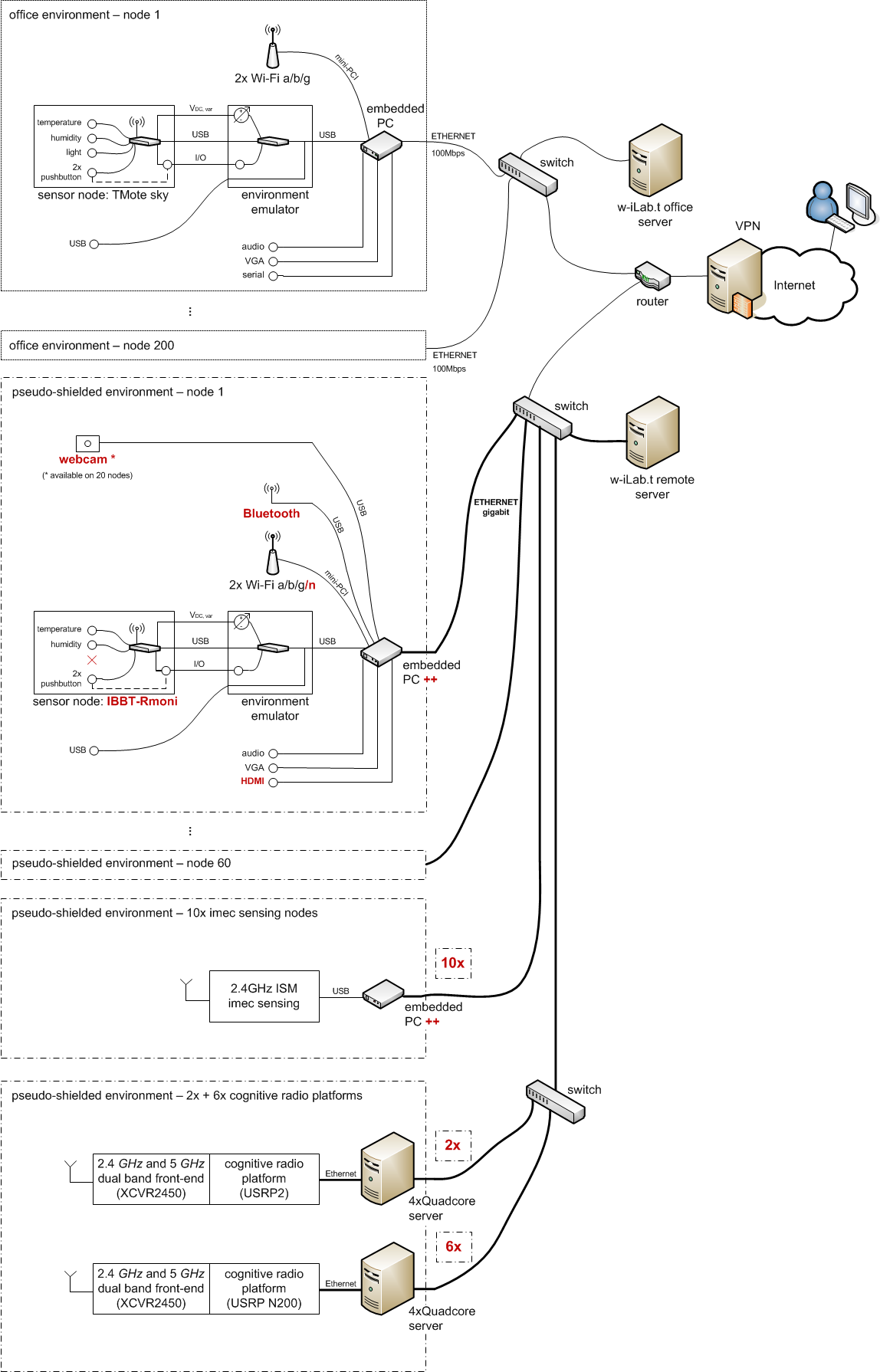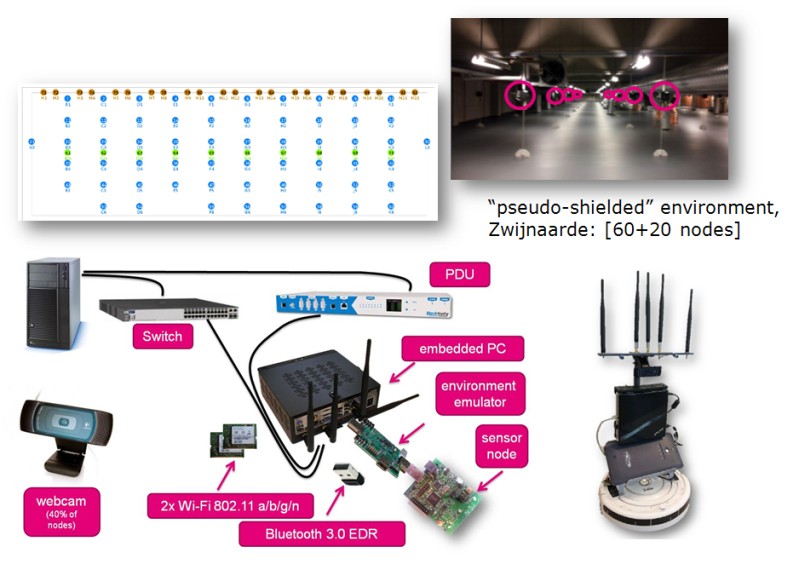Overview¶
The w-iLab.t (short name: wilab) is an experimental, generic, heterogeneous wireless testbed deployed in the iGent building and at a second, remote location. w-iLab.t provides a permanent testbed for development and testing of wireless applications via an intuitive web-based interface.
w-iLab.t hosts different types of wireless nodes: sensor nodes, Wi-Fi based nodes, LTE enabled nodes, sensing platforms, and cognitive radio platforms (that are limited to operating in the ISM bands due to license restrictions.)
The wireless nodes are also connected over a wired interface for management purposes. Each of the devices can be fully configured by the experimenters. As the Ethernet interfaces that are put in place for management reasons can also be used during experiments as a wired interface, heterogeneous wireless/wired experiments are possible. As such, a very large number of (wireless) network experiments may be executed.
Click on the thumbnail below to get an overview picture of the hardware available in w-iLab.t:

w-iLab.1¶
Nodes (both sensor nodes and embedded PCs with Wi-Fi interfaces) are installed at 150 spots over three floors of an office environment (9,10,11) and in the datacenter on the ground floor (44 nodes).
The map of the nodes can be found at http://wilab1.ilabt.iminds.be/inventory. Nodes can also be reserved at this page.
w-iLab.2¶
This testbed is a secondary deployment located in Zwijnaarde, nearby Gent, Belgium. The nodes are located at 100 spots throughout a utility room (on top of the clean room).
At w-iLab.2, there is almost no external radio interference. Every node-spot is equipped with:
- 1 embedded PC with 2 Wi-Fi a/b/g/n or ac interfaces and 1 IEEE 802.15.1 (Bluetooth) interface
- a custom iMinds-Rmoni sensor node with an IEEE 802.15.4 interface or a Zolertia Re-Mote sensor node
- an “environment emulator” board (enabling unique features of the testbed including the triggering of repeatable digital or analog I/O events at the sensor nodes, real-time monitoring of the power consumption, and battery usage.
There are several additional possibilities:
- A number of cognitive radio platforms (including USRPs) as well as specialized spectrum scanning engines are available at this location. This enables state-of-the art research in the field of cognitive radio.
- two LTE femto-cells with a number of LTE enabled wireless nodes (USB-dongles on Linux hosts or Android smartphones)
- 16 mobile robots
The map of the nodes can be found at https://boss.wilab2.ilabt.imec.be/inventory/. Nodes can also be reserved at this page.

Possible experiments¶
A short introduction to different possible experiments is presented below.
Sensor node experiments¶
Registered users can create their own executables, upload these executables, associate those executables with a selection of sensor nodes (this process is called “creating a job”), and schedule the job to be run on wilab.
During the job, measurements and management data is logged to a database. This info is presented to the user upon job completion and may then be used for processing and visualization. In addition, real-time visualization tools are provided which make it possible to follow the state of the testbed and the experiment, while a job is still running. As such, w-iLab.t facilitates research in sensor network programming environments, communication protocols, system design, and applications.
Wi-Fi experiments + embedded PC’s¶
Experimenters can also fully control the embedded PC’s that are available. The embedded PCs run a Linux distribution and are equipped with two Atheros based Wi-Fi interfaces. These Wi-Fi interfaces may or may not be used during experiments. It is up to the user to define the behavior of the embedded PCs by installing software and/or scripts on the nodes.
As such, the embedded PCs can be used for a very broad set of experiments. Just to give a few examples, it is possible to:
- enable a single wireless interface; configure it as an access point -> use of the embedded PC as an access point
- enable two wireless interfaces in ad-hoc mode -> use of the embedded PC als a two-interfaced Wi-Fi ad-hoc node
- install any type of software on the node: e.g. a webserver, a spectrum database, an aggregator node, …
An experimenter can access the embedded PCs individually via SSH, or distribute software/drivers/kernels/scripts/… to multiple nodes at once, by using the web-based testbed interface. During the experiments, a directory on a w-iLab.t storage server is mounted automatically for logging purposes. Alternatively, experimenters may log information to their own storage servers, or store information to a database.
The default image of the embedded PCs in the office environment comes with the Madwifi wireless driver preinstalled. Experimenters may install their own drivers and protocols to the embedded PCs. As a general rule: everything you are able to do with an embedded PC with Atheros Wi-Fi cards on your own desktop, can also be implemented on a large scale in the testbed.
At the w-iLab.2 location, USB Bluetooth interfaces are also plugged in to the embedded PCs. Please check the hardware overview picture above to know what is connected to the embedded PCs at which location.
Cognitive networking platforms¶
In w-iLab.2, a set of cognitive networking platforms are available. They can be remotely accessed over the internet. For information on which cognitive devices are available, please check the hardware overview image on top of this page.
Again, it is up to the experimenters to decide how to use the hardware that is made available. Signals may only be transmitted in the 2.4 GHz and 5 GHz ISM band due to license restrictions.

